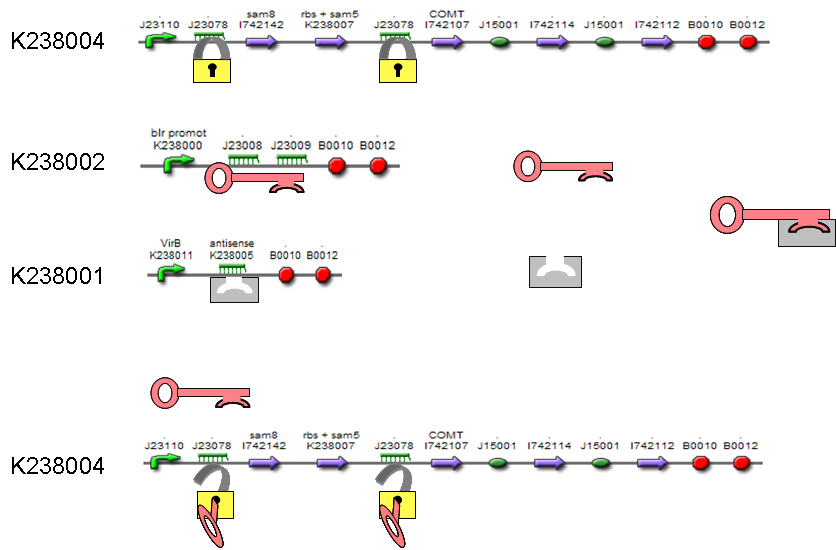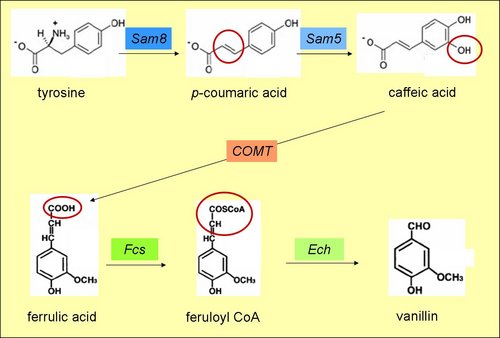Team:KULeuven/Project/Details
From 2009.igem.org
Bart Bosmans (Talk | contribs) |
Bart Bosmans (Talk | contribs) |
||
| Line 35: | Line 35: | ||
| - | The first gene Sam8 originates from Saccharothrix espeanensis and encodes a tyrosine ammonia lyase. This enzyme catalyses the deamination of tyrosine's amine group and converts tyrosine to p-coumaric acid. Sam5 is derived from the same species, but encodes a 4-coumarate 3-hydroxylase which hydroxylates C4 in the aromatic ring of p-coumaric acid. p-Coumaric acid is converted to caffeic acid. | + | The first gene Sam8 originates from ''Saccharothrix espeanensis'' and encodes a tyrosine ammonia lyase. This enzyme catalyses the deamination of tyrosine's amine group and converts tyrosine to p-coumaric acid. Sam5 is derived from the same species, but encodes a 4-coumarate 3-hydroxylase which hydroxylates C4 in the aromatic ring of p-coumaric acid. p-Coumaric acid is converted to caffeic acid. |
Revision as of 07:40, 1 September 2009
Contents |
Blue light receptor
The protein YcgF is a known blue-light sensor in certain E. coli strains. Upon photo-excitation it dimerizes and acts as an anti-repressor for YcgE. YcgE is bound to the promotor-region and inhibits RNA Polymerase. The dimerized YcgF interacts directly with the repressor, releasing it from the DNA and allowing transcription. We designed the [http://partsregistry.org/wiki/index.php?title=Part:BBa_K238002 BBa_K238002] part in such way that irradiation with a certain amount of blue light activates transcription of key-mRNA. To achieve this, we purified the promoter-region of E. coli MC4100. After mutating out possible restriction sites, the blr promot, [http://partsregistry.org/wiki/index.php?title=Part:BBa_K238000 BBa_K238000] part was added to the registry.
Key/Lock
The mRNA ‘key’ and ‘lock’ sequences form a pair of riboregulators. The ‘lock’ DNA is located directly upstream of the controlled gene’s RBS. It is folded into a stem-loop secondary structure which prevents access to the ribosome and inhibits translation. ‘Keys’ are expressed from separate genes (in trans) and code for sequences complementary to the lock. Upon annealing they unlock the ‘closed’ stem-loops, thereby exposing the RBS and permitting expression of the gene(s) downstream.
The most efficient key is a combination of the [http://partsregistry.org/Part:BBa_J23008 BBa_J23008] and [http://partsregistry.org/Part:BBa_J23009 BBa_J23009] keys. They are placed behind the blue light promoter to ensure transcription after blue light irradiation. [http://partsregistry.org/Part:BBa_B0015 BBa_B0015] is used as terminator. This brick consists of [http://partsregistry.org/Part:BBa_B0010 BBa_B0010] and [http://partsregistry.org/Part:BBa_B0012 BBa_BOO12] and is most commonly used. One [http://partsregistry.org/Part:BBa_J23078 BBa_J23078] lock is placed before Sam5 and Sam8 genes and another before COMT to guarantee maximal efficiency of the key/lock system. These genes are part of the vanillin production pathway. Therefore, after a blue light activates key-transcription, vanillin-synthesis starts.
Vanillin production
A vanilla odour is created by synthesizing the molecule Vanillin. The starting point is tyrosine, an amino acid produced endogenously in E.coli. The subsequent pathway involves a combination of five enzymes, biobricked with following codes:
• SAM8: [http://partsregistry.org/Part:BBa_I742142 BBa_I742142]: coding sequence without RBS
• SAM5: [http://partsregistry.org/Part:BBa_K238007 BBa_K238007]: RBS site + PstI restriction site removed
• COMT: [http://partsregistry.org/Part:BBa_I742107 BBa_I742107]: coding sequence without RBS
• FCS: [http://partsregistry.org/Part:BBa_I742115 BBa_I742115]: RBS + fcs in pSB1A2
• ECH: [http://partsregistry.org/Part:BBa_I742113 BBa_I742113]: RBS + ech in pSB1A2
The first gene Sam8 originates from Saccharothrix espeanensis and encodes a tyrosine ammonia lyase. This enzyme catalyses the deamination of tyrosine's amine group and converts tyrosine to p-coumaric acid. Sam5 is derived from the same species, but encodes a 4-coumarate 3-hydroxylase which hydroxylates C4 in the aromatic ring of p-coumaric acid. p-Coumaric acid is converted to caffeic acid.
COMT if found in the alfalfa plant and translates to a caffeic acid-O-methyl transferase. After -OH methylation on C4 of the aromatic ring, it produces ferrulic acid from caffeic acid. The fourth gene Fcs is derived from Pseudomonas fluorescens and encodes feruoyl CoA synthase. This enzyme ligates acetyl-CoA onto ferrulic acid and produces feruloyl CoA. Ech another enzyme from the same species completes the pathway. The gene-product, an enoyl CoA hydratase, cleaves the CoA group from feruloyl CoA thereby converting it to vanillin.
The entire [http://partsregistry.org/Part:BBa_K238004 BBa_K238004] biobrick is placed under a constitutive promoter [http://partsregistry.org/Part:BBa_J23110 BBa_J23110] and terminated by [http://partsregistry.org/Part:BBa_B0015 BBa_B0015].
 "
"





